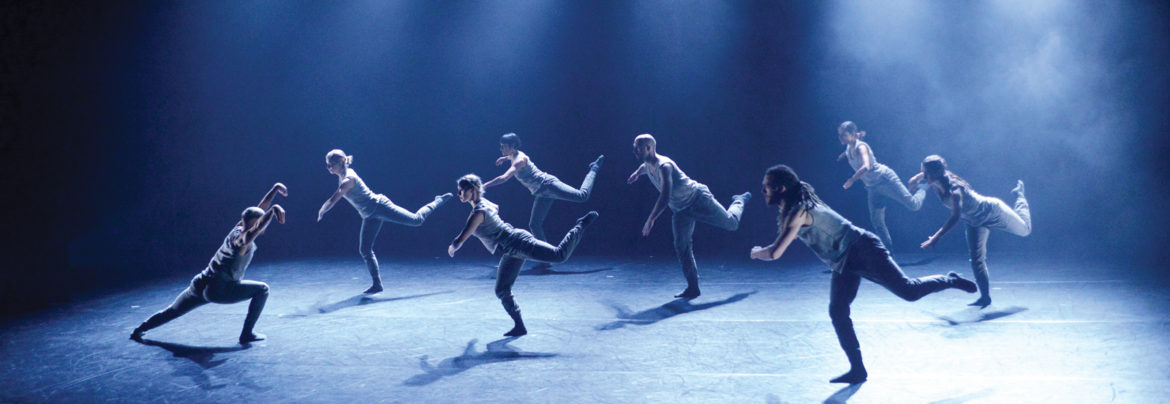Toronto: Spring 2017 - Vancouver Ballet Society
- Home
- City Reports 2015 - 2019
- Toronto: Spring 2017

by Michael Crabb
After the long summer drought, the wave of often overlapping performances that engulf the Toronto dance scene each fall can be overwhelming. However, as the wave recedes, certain images and impressions remain memorably fixed. Some are very specific, others more the result of cumulative impact.
Into the former category falls Bill Coleman’s extraordinary presence in Dollhouse, a collaboration with avant-garde composer and sound artist Gordon Monahan. Dollhouse utterly defies adequate description and exists outside any widely acknowledged category. It harks back to the glory days of performance art, but without the self-conscious transgressive nature. There are comic moments that verge on slapstick, yet Dollhouse’s general atmosphere is absurdist. There’s a dark vein that summons thoughts of Beckett, Brecht and Kafka.
The middle-aged Coleman first made his mark years ago as an accomplished dancer of admirable technical facility. In Dollhouse, his movements are mostly spare and minimal, yet devastating in their impact. He is an Everyman, a Chaplinesque figure pitched into a surreal environment contrived to hobble him at every turn.
The opening scene offers a taste of what unfolds. A dark-suited Coleman stands motionless for an uncomfortably long time in the still fully lit theatre, which is the home of presenting company Canadian Stage. You can tell his every sense is hyper-alert. Then Coleman begins to move, tentatively and awkwardly, as if sensitive to some lurking danger.
Soon we hear odd cracking sounds. They come from within Coleman’s suit. As his body crumples, rather like the Scarecrow in The Wizard of Oz, shards of shattered plastic glasses begin to spill forth. It’s at once funny and horrifying. As Coleman’s assorted misadventures continue, we quickly see him not as a performer, but as a very real and disquieting proxy for any number of universally recognizable and existential anxieties.
Claudia Moore’s MOonhORsE Dance Theatre marked its 20th anniversary in November with the 39th edition of its popular series Older & Reckless. It was a rich program, including solo appearances by Margie Gillis, Robert Desrosiers and Moore herself. The image that haunts was collectively generated — a community project comprising 29 performers, some local dance-scene veterans, others amateurs, who covered a range of ages and body types. The work, Danser Joe, is a compact version of Jean-Pierre Perreault’s 1983 JOE, the late choreographer’s defiantly stomping and seminal tribute to the plight of the downtrodden masses. As the cast in their long raincoats, fedoras and boots executed Perreault’s increasingly complex tattoo, the essence of the choreographer’s purpose communicated with a freshly raw, authentic power.
Fearful Symmetries, described by its composer John Adams as “a seriously aerobic work, a Pantagruel boogie with a thrusting, grinding beat,” has understandably attracted many choreographers, including Roberto Campanella, co-founder/artistic director of Toronto’s ProArteDanza. His version, titled after the score, is Campanella’s best work in years. Adams’ music compels movement, but its structural symmetry can be misconstrued as an invitation to choreographic platitudes. Campanella avoids these. His response to the score has human urgency. It’s essentially abstract, but emotionally resonant. He’s come up with a movement motif of running that is both kinetically thrilling and psychologically ambivalent. Is this ensemble actually getting anywhere or merely struggling to keep up with an ever-changing world?
Among visiting troupes, Nederlands Dans Theater continues as a reminder of what can be accomplished by the human body in motion. These are dazzlingly exciting dancers, apparently capable of executing whatever a choreographer orders. But there are limits to the abilities of even the finest dancers — however gorgeous they may look — to bring substance to the inherently insubstantial.
In a triple bill featuring two works by NDT artistic director Paul Lightfoot and his longtime choreographic partner Sol León, it was only the opener by Crystal Pite, a Canadian, of course, who rose above the affected portentousness of so much contemporary European dance.
Of the León/Lightfoot offerings, Safe as Houses from 2001, with its symbolic rotating wall, was the stronger. The sense of elusive reality and unpredictable change made the work more than a display of technically breathtaking dance. Oddly, the other work, Stop-Motion, made in 2014, seems rooted in a similar, now rather dated aesthetic, even if the mood is more overtly emotional and personal.
Pite’s In the Event from 2015 has clear links physically and thematically to much of her earlier work, but its sheer inventiveness and ability to evoke complex emotional responses through what are often taut physical means is what leaves you gasping in wonder. It impresses by not striving to impress.
As for the National Ballet of Canada, it launched its 2016-2017 home season unadventurously with a couple of familiar and dependable full-length story ballets, James Kudelka’s 2004 version of the Prokofiev-scored Cinderella and John Cranko’s Onegin, made originally for Stuttgart Ballet in 1965 and a more-or-less staple of the Toronto company’s repertoire since its Canadian premiere in 1984.
“Dependable” is not quite the same as “best-selling.” Cinderella is a well-known story with an easily pronounced title. Onegin is neither, despite its passel of avid devotees. Thus, the former got 10 performances and the latter six. This is unfortunate because Onegin is a strongly character-based ballet and its meaty leading roles are justly coveted by those who aspire to be recognized as accomplished dance-actors. Yet, with relatively few performances, the opportunities are limited.
The run of Cinderella featured several debuts — most notably that of second soloist Emma Hawes in the title role. Hawes is already very much on National Ballet fans’ radars, and she did not disappoint. Following Kudelka’s intentions, she offered a feisty if put-upon young woman in Act I before transforming into a ravishingly poised and elegant mystery guest at the prince’s ball. With McGee Maddox as her strong and seasoned partner, Hawes negotiated Kudelka’s almost wilfully perilous choreography with suitably romantic abandon.
On the Onegin front, there was only one title-lead debut, that of Piotr Stanczyk. He was awarded a single show and seemed determined to make the most of it. It was also apparent that Stanczyk had given the role a great deal of forethought; it was not that his portrayal looked in any way calculated, but rather that it was intelligently considered. His Tatiana, the woman Eugene Onegin initially spurns, was veteran ballerina Sonia Rodriguez. There is a palpable chemistry between these two fine dancers and it injected real fire into their climactic Act III pas de deux when it is Tatiana’s turn to reject Onegin.
In the case of works such as Onegin featuring over-the-top romance and heartbreak, ballet fans tend to develop very particular allegiances. They will propound, often with alarming vehemence, what they regard as the superior merits of their idols. In truth, however, it often comes down to questions of taste. That said, it would have been hard not to be deeply affected by the sheer dramatic intensity of Svetlana Lunkina’s debut as Tatiana, partnered by former Stuttgart Ballet dancer Evan McKie in his National Ballet debut as Onegin. Their single performance was the last of the run and, for fans, the most keenly awaited. To say it was electric rather understates the case.

